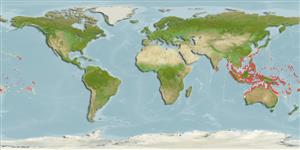Common names from other countries
Environment: milieu / climate zone / depth range / distribution range
Écologie
Récifal; profondeur 3 - 20 m (Ref. 8294). Tropical; 36°N - 31°S, 32°E - 137°W (Ref. 847)
Indo-Pacific.
Length at first maturity / Taille / Poids / Âge
Maturity: Lm ? range ? - ? cm Max length : 30.0 cm COLD mâle / non sexé; (Ref. 269)
Description synthétique
Morphologie
The coral is circular in outline, up to 30 cm in diameter. The upper surface is fairly rough due to moderate to deeply incised septal dentations on most septocostae, and the lower surface is rough due to costal spines (Ref. 269). The coral is circular in outline, up to 30 cm in diameter.
Maximum depth from Ref. 98471. Found at intermediate depths on reef slopes (Ref. 269). Also on back reefs, reef flats, and lagoons. Solitary, free-living (Ref. 98471).
Life cycle and mating behavior
Maturité | Reproduction | Frai | Œufs | Fécondité | Larves
Mature gametes are shed into the coelenteron and spawned through the mouth. Life cycle: The zygote develops into a planktonic planula larva. Metamorphosis begins with early morphogenesis of tentacles, septa and pharynx before larval settlement on the aboral end (Ref. 833).
Hodgson, G. 1998. (Ref. 269)
Statut dans la liste rouge de l'IUCN (Ref. 130435)
statut CITES (Ref. 108899)
Not Evaluated
Utilisations par l'homme
| FishSource |
Outils
Sources Internet
Estimates based on models
Preferred temperature
(Ref.
115969): 25.4 - 29.3, mean 28.6 (based on 2495 cells).
Vulnérabilité
Low vulnerability (20 of 100).
Catégorie de prix
Unknown.
